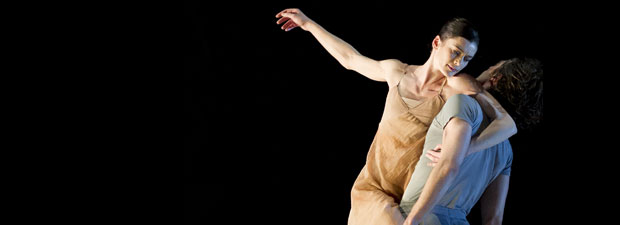
Paris Opera Ballet
Romeo and Juliet (Roméo et Juliette)
Paris, Opera Bastille
12 May 2012
www.operadeparis.fr
Sasha Waltz’s version of Romeo and Juliet is set in another universe: an abstract, fractured one. Many moments reference Shakespeare’s play, making us sure we’re watching Romeo and Juliet’s story. Yet this Roméo et Juliette lacks many of the play’s hallmarks: there’s no Benvolio, Paris, or Rosaline; no Mercutio or Tybalt. Instead, we have three main characters – Roméo, Juliette, and Père Laurence – along with a corps de ballet of nine women and ten men, three opera singers, and a large, singing chorus. The singers are frequently onstage during the performance. While it’s great to see dance and music brought together in that way, I also found it distracting when the singers began to move along with the dancers.
At first, it’s hard (at least for me) to adjust to an abstract, contemporary Roméo set to the Berlioz symphony, rather than to the straightforward, indelible narrative combination of Prokofiev’s music and Sir Kenneth MacMillan’s choreography. (The Paris Opera Ballet also performs a classical version of Prokofiev’s Roméo et Juliette with Rudolf Nureyev’s choreography.) However, some of this abstraction is refreshing and beautiful. In the opening scene, for example, dancers use their arms as swords, clashing in straight, strong lines. It’s too bad this motif doesn’t come up more often.
The piece’s abstraction is thought-provoking. Until the balcony scene, it’s harder to separate Romeo and Juliette from the crowd. (Aurélie Dupont has such presence, however, that it’s easy to realise when Juliette appears.) In the ballroom scene, while the lovers are in the foreground, they’re among many other couples who are all dressed similarly, performing similar steps. All the couples spend time embracing, like wind-up dolls. They all take turns collapsing, only to be brought up and into vertical alignment again, almost immediately. All this movement seems to indicate that death isn’t permanent; if you fall, you simply rise again.
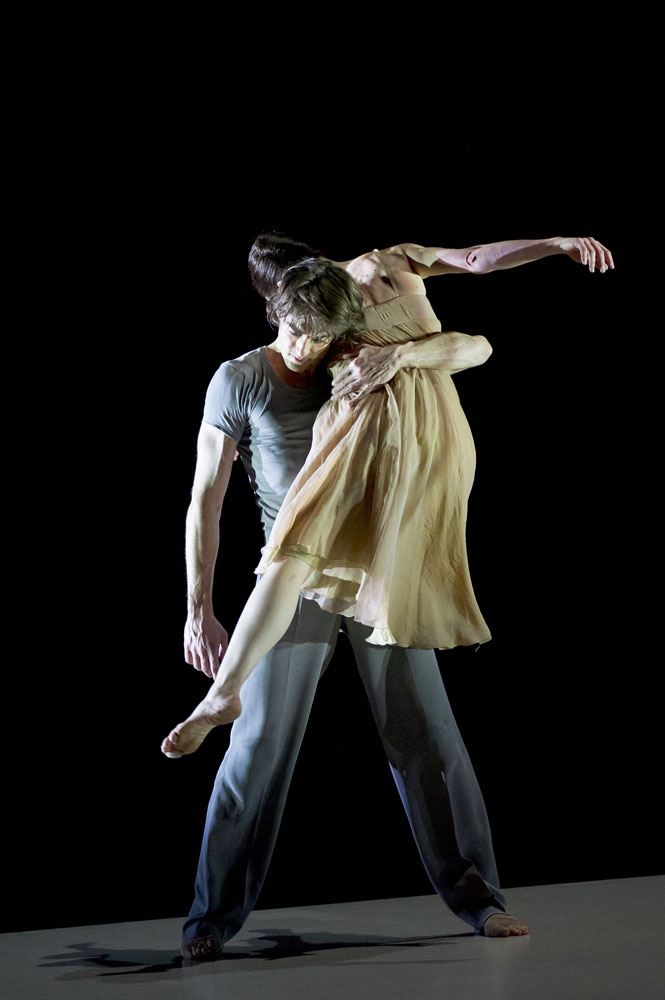
All through the ballroom scene, these characters, including Roméo, Juliette, and their couple compatriots in the corps, are all having the same experiences. Each pair is starring in their own love story. This similarity is heightened by the costumes, which are basically the same for all the corps members in each scene, except for changes in small details: sleeve length, neckline, shade of color. In the ballroom scene, the women all put on metallic tutus, but don’t wear pointe shoes. Strangely Juliette stays on the edge of the stage after the ballroom scene, her back to the audience, and changes out of her tutu into a dress. Why not leave, change costumes, and return? Taking off a tutu is awkward and distracting.
At the beginning, the characters are divided between light and dark. I thought at first the colors could signify the separation between Capulets and Montagues. However, that ends by the next scene, as the corps keeps changing costumes (both shapes and colors). By the end, united in their grief, the corps all wear shades of cream – except for a shirtless Père Laurence, who is in wide-legged black pants.
Overall, the costuming contributes to a lack of concrete place and space. The dancers’ clothes are no help in establishing sides, nor is the movement; every supporting character, it seems could be Capulet and Montague both. Perhaps that confusion is precisely the point. The dancers are all the same, yet they think they’re different. In a way, this idea is as sad as that of the lovers’ deaths. I’m sure my interpretation here is drawn from or inspired by the promotional materials on the company’s website, which specify Waltz’s interest in focusing on ideas about love and death, distinguishing these concepts from the story itself: “She (Waltz) distances herself from any kind of narrative in order to evoke the emotion contained in this tragic love story. The ballet becomes timeless and explores the relationship between love and death and the obstacles which, still today, continue to separate those who love each other.” The choreography seems to emphasize, too, this strange blend of individuality and universality.
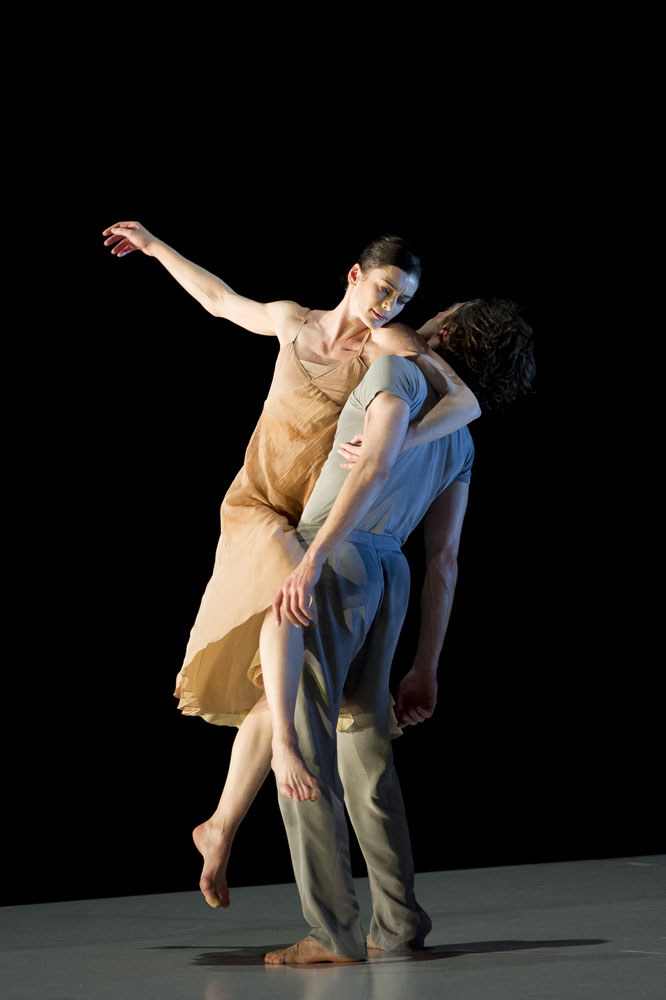
Yet despite the emphasis on removing the narrative, some of the most interesting parts of this piece come from clear references to the Romeo and Juliet story or to other Romeo dances. Take the meeting in the ballroom scene (which reminded me of a rave), when the two lovers first touch hands: “palm to palm is holy palmers’ kiss.” Juliette is in her tutu, barefoot; this is both a reminder and a repudiation of the classical. She and Roméo share a moment of stillness as life proceeds behind them. To everyone else, it’s an ordinary moment, but for the lovers everything has changed.
In the high point of the work, the balcony scene, Juliette and Roméo move in pure contemporary style, flowing like water over and around each other’s bodies. In the middle of their excitement, they stop to allude to classical ballet. Roméo kneels, Juliette approaches, they embrace. Later, he catches and kisses the hem of her dress as he pulls away. As Juliette, Dupont was wonderful: she committed to Waltz’s contemporary style so beautifully and thoroughly that it was surprising to remember she had been a technically strong, classical Manon just days earlier. When Dupont, as Juliette, stumbles onstage before her pseudo-death, she seems to have already taken her drugs. She sways, rather dazed, before collapsing. There’s no despairing decision-making, no pondering of fate. By the time we see her, she’s already selected a course of action. She had a good partner in Hervé Moreau (Roméo), who showed off lovely lines, especially in his port de bras. The slightest hint of classical purism peered in through his contemporary steps, especially in the wild solo he performed to silence.
The set is a fantastic, intuitive piece that moves along with the dancers and gradually transforms with the action, becoming whatever those characters need it to be. At first a set of two geometric four-sided tiers, laid slightly askew on top of each other, the top layer begins slowly rising after the ballroom scene, becoming a balcony and then separating the lovers. When Roméo decides to run, it becomes an impossible wall, which he kept racing up and sliding down: a thrilling effect. Later, the tiers collapsed into a giant rectangle (still at an angle), providing a crypt for Juliette and then Roméo.
The end of the ballet isn’t as strong as the rest. After Juliette drugs herself, Père Laurence (Nicolas Paul) and some of the corps come onstage, solicitously, to place her in the crypt. After that, they pull out small bags of rocks and pour the rocks out around her. Her face and white dress peer out: it looks like a modern flower arrangement gone wrong. The rocks are noisy, too. What is no doubt intended as a solemn scene provided unintentional humor when one corps dancer dropped one of the rocks – the sound echoed throughout the Opéra Bastille.
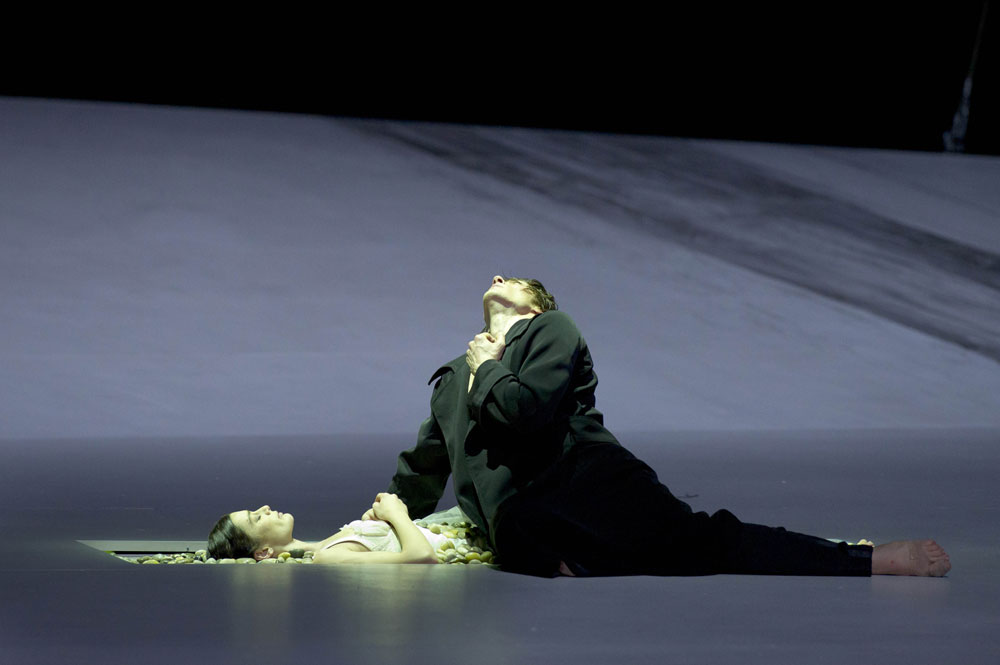
When Roméo comes in, things perk up in a strange sort of way. He falls upon Juliette and she awakens; they dance briefly together, in a nice variation on the usual type of crypt pas de deux, before he collapses again, now dead. Juliette then kills herself. Typically, dance versions of Romeo and Juliet end here, and in this performance I wished they had too. Instead, the corps and Père Laurence come out to re-bury the lovers, and then perform a very long and mournful dance, joined by the chorus and the baritone.
While this large group danced and sang, I didn’t get caught up in a shared version of a community’s grief. Instead, I kept thinking about how difficult it must be for Roméo and Juliette to lie on those rocks, playing dead, while the chorus makes mournful groupings and the singers take turns collapsing to the ground.
The actual Roméo and Juliette sections of Waltz’s work are captivating, but when they stop dancing, it’s harder to remain invested in what’s going on around them. Even in an abstract version of Roméo et Juliette, Romeo and Juliet remain the focal points.










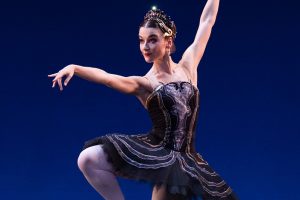


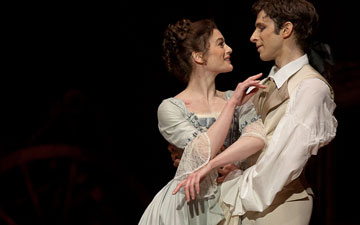
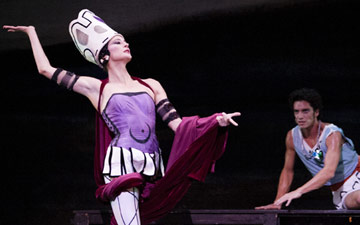

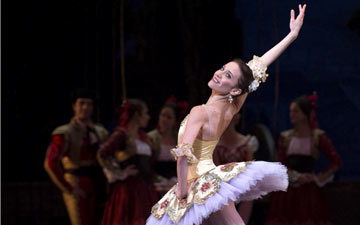
I saw this production when it was originally performed back in 2007 and found it very touching. The Berlioz composition with orchestra and chorus was amazing. In fact at the end it reduced me to tears, so much so, I ordered on CD as soon as I retruned to the UK. It is so diffetent to the norm, I am usually very much a classical supporter and do not find the modern works to my liking. But this version by Sasha Waltz has changed that and I am eagerly awaiting the DVD with Aurelie Dupont and Herve Moreau to be released as it was filmed during the recent run at the Opera Bastille.